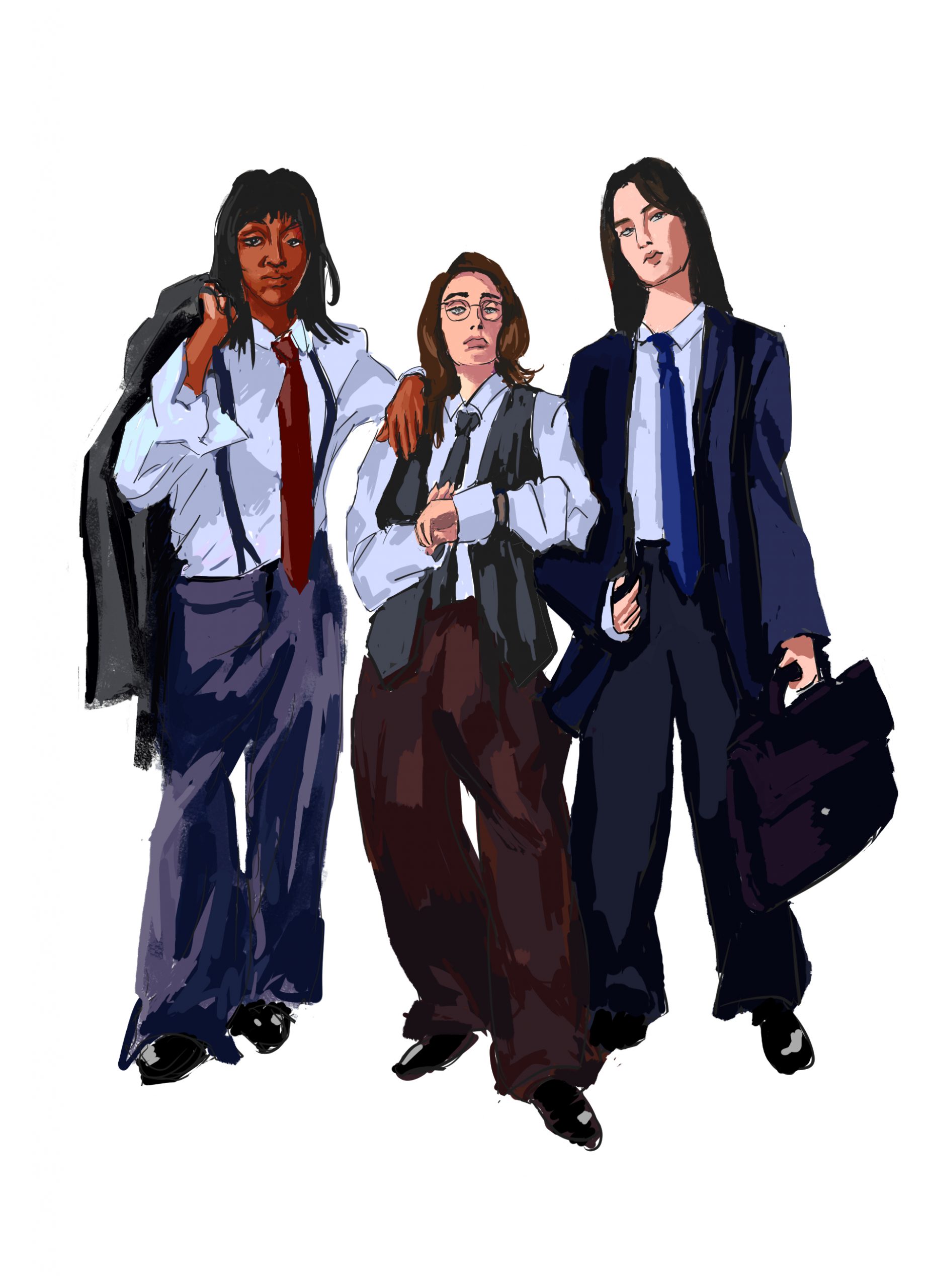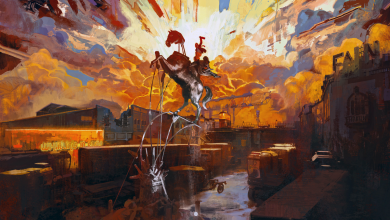Just to be Queer Here: “Bottoms” is Only the Beginning

Artwork by Emily Hu.
Image Description: Illustration of Ayo Edibiri, Rachel Sennott, and Emma Seligman in baggy suits. Edibiri slings a jacket over her shoulder, while Seligman carries a black briefcase.
When friends asked me to drive 45 minutes to find the singular screening in a 30-mile radius of a movie about high school losers, I had some cynicism. But Emma Seligman’s already singing reputation inspired me to join my friends in putting on the longest shorts we could find, layering our flannels, and venturing off into the rainy highway on the outskirts of town (where all silly and violent gays find their supporters apparently).
Even just five minutes into Emma Seligman and Rachel Sennott’s queer dark-comedy “Bottoms,” I knew my extra gas mileage and damp flannel was well worth it. The film follows two gay high school losers who create a fight club in a scheme to hook up with the hot cheerleaders. While the premise may ring bells of several nostalgic high school comedies, Seligman and Sennott brought the hungry eyes of Gen Z something fresh to feast on.
What makes this high school comedy different? Why is “Bottoms” special? Let’s get into it.
This movie is more than a gay reclamation of the genre and tropes that excluded it for decades, it’s an emblem of the uninhibited joy and more importantly, the sincerity that comes from creatives – and friends – creating the art they want to see. The unapologetic candor and collaboration of this film allowed it to be a funnier, sharper, more earnest comedy, and an infinitely more honest representation of this generation of women, gays, and high school losers.
Though it was a long shot this movie would even be made just for that reason: it’s not palatable, and in no way does it try to be. Sure, spec scripts can get green-lit all the time, but a spec script from two fresh college grads? About gay high schoolers? From development, the film represented a diamond in the rough anomaly. Many studios passed on the script before Alana Mayo at Orion Pictures saw the queer sparkle of Josie (played by Ayo Edbiri) and PJ (played by Rachel Sennott). Seligman explains that not only did Orion like the script but Alana, and everyone who was working on the project, “whether you were financing it, or you were one of the actors, or you were doing the sound edit – you knew what they were getting into.” But the serendipity of getting scripts into the right hands isn’t the only way “Bottoms” broke the Hollywood mold.
After all, Seligman had been testing the waters and introducing her own pleasantly inciting ideas long before “Bottoms” premiered. Seligman wrote “Bottoms” at the same time as her thesis-short-turned-feature-film “Shiva Baby.” The “Shiva Baby” feature pulled the young director’s into the headlines and created a following for her lead actor and frequent collaborator, Rachel Sennott. After meeting at NYU, Seligman and Sennott saw in each other a desire to write and produce that they hadn’t found in their other classmates. “There are so many times when you’re like, ‘We should do something’ or people are like, ‘Let’s make a movie,’ and then you text them, ‘Can we meet?’ and they’re like, ‘I should be free in three months,’” Sennott said during an interview with Indiewire. “Emma and I really connected over both wanting to do it and not being afraid to say, ‘I want to do this.’” They were down to put in the work. And work they did.
The idea for “Bottoms” was, like all great things, born on a basement whiteboard. “Tampons!” “Blood!” “Explosion” “Sex!” they tossed words onto the board, writing down everything they wanted to see. Regarding ideas like a school mascot with a penis, Seligman recounts, “I can’t believe Rachel took a millisecond to write this joke in a coffee shop five years ago. Now we’re here spending hours trying to figure out what this looks like.” [Is it fuzzy? How long is it?]
Seligman describes how their collaboration works well as Sennott’s comedic brain “goes there” and creates vast comedic material to pull from, while Seligman focuses on the structure – making it grounded and make (some degree of) sense. The movie often feels like a college improv group actually filmed and developed their bits, or like the endless riffing that comes from two best friends sharing a bottle of wine. And Seligman and Sennott surely did. The writers never traded drafts, but instead always wrote in the same room, which you can feel through the script’s smooth riffs and colorful joking digressions. The script was born from two friends trying to see just how outrageous and stupid they could make this little world on the page.
The world of “Bottoms” is outrageous perhaps but most definitely curated. Seligman drew from an amalgamation of teen movies for various aspects of the film: “Bring it On”, for ensemble humor and absurdity, Scott Pilgrim and Kick Ass for the loser-hero types, “Grease” and “American Graffiti” for production design, and “Mean Girls”, “A Cinderella Story”, and “She’s the Man”, for general inspiration. With this vast tapestry of high school cringes and meet-cutes, Seligman began to construct the rules of her world. With such a surreal and absurd cinematic backdrop, it was an endeavor to decide where the “no-need-to-think-practical” line stopped. Seligman and Sennott leaned on friend and costar Ayo Edibiri to help them sift the script for reasonable and unreasonable anti-logic. Some absurdities could be compromised, but one of the most critical components of this universe was made clear in the very first scene: The characters aren’t losers because they are gay, they are losers because they are losers. Losers are losers no matter their sexuality.
“Bottoms” takes all the tired high school love story tropes and doesn’t ignore them; instead, it leans in as far as it can and uses them with the queerness and campness our generation craves. It is a movie that knows exactly what it is.
Visually and musically the landscape of “Bottoms” is a universe floating between the 80s, 90s, and 2000s. Some characters use flip phones and others use walkmans. The technology intentionally resists identifying any specific time and allows Seligman to indulge in an alternate history. Seligman told the Guardian, “ I wanted to put queer characters into all the different decades of teen movies that we missed out on seeing ourselves in.” Seligman wanted it to be “like these queer characters could exist in any time period,” she told Vanity Fair.
The timelessness of “Bottoms” is part of what makes this cast shine. Seligman wanted what she describes as “what the fuck casting”: a melting pot of models, influencers, and football players that together would create a sense of disunion. This is yet another example of “Bottoms”’ uninhibited authenticity. Unlike so many celebrated movies of the high school genre where each alleged teenager looks like they hopped out of an Abercombie and Fitch ad (or worse – the CW) the “wtf casting” feels like the nonsensical coalescing of every high school’s idiosyncratic characters. It works. Disunion within an ensemble is really as high school as it gets.
The integrity of the casting makes “the nerd” and “the cheerleader” take new shape, pushing them beyond the stereotypes and nostalgic punch lines. When looking to cast the character of Hazel (played by the ever-charming Ruby Cruz), the casting team was surprised by the new colors Cruz brought to the text: this character was a nerd who was also…secretly very cool. The role suddenly contained a mix of self-confidence and the desire to be part of something larger. In an interview with IndieWire, Seligman reflects that “when you are inserting queer characters into these tropes from the teen movie genre they will come out differently, they can’t just copy what has been done. That happened naturally with Hazel.” Through organically and authentically incorporating queer characters into long-known tropes, this film sparked a newness within a potentially stale landscape. While this isn’t a story ABOUT being gay, by virtue of incorporating queer characters it IS inherently a new story.
The mold-breaking bravery of “Bottoms” doesn’t come solely from its casting, but from its unsympathetic protagonists as well. Despite the beloved genre and despite Hollywood’s feigned claims of promoting new stories and quote-un-quote-diversity, Seligman says “people were so offended by the content of the movie! I just don’t think they would say the same thing about two straight male leads. Would they be as offended by “American Pie” or “Superbad?”” Right? Okay…well… why? Because we are much more comfortable with women playing roles like a cheerleader (hilariously spun by Havana Rose Liu) or even the nerd-side kick. But to have such vulgar and selfish women at the helm, it’s testing.
These characters are selfish and these writers have no shame — especially when it comes to the hottest word: feminism. While many high school movies inlay “girl power” moments and feminist jargon, these writers were interested in accessing empowerment from an alternate angle, much like the women of our generation. Seligman told The Guardian that“…what felt empowering [was] to show the shittiest versions of these characters. I think Rachel and I see a lot of pressure for female friendships on screen to be super supportive and loving and not complicated – and, like, ‘girlboss’. Those things are awesome, but we were really excited to show characters who are ready to manipulate that idea, as opposed to genuinely promoting it.” As a critical Gen Z viewers, the audience recognize disingenuous activism: too frequently organizations, marketing, and movie-makers, co-opt activist language for disingenuous purposes, and that’s exactly what these characters do. I’m tempted to say “good for them.” We can see through the B.S. and it’s refreshing to see a plot that addresses that rather than a film that represents it.
Whether it’s a cult classic or not, “Bottoms” is more than just nostalgic for the wild time of 2023. It’s emblematic and — dare I say — optimistic for a new generation’s vision of filmmaking. The film’s disregard for social and cinematic etiquette perfectly encapsulates the frustration of today’s youth, presenting a story that is as joyous as it is delightfully uncomfortable. Seligman and Sennot did more than create a gay reclamation of the high-school movie genre; they demonstrated that two silly and eccentric women can become, as the New York Times states, “major new forces in American comedy” by their own brute enthusiasm and drive. This film marks the beginning of a fast-approaching rise of writers and stars like Emma Seligman, Rachel Sennott, Ayo Edibiri, and others. It also inspires the long-awaited progression of more honest filmmaking that is less worried about “saying something” and instead actually does. So just to be queer here: we’re entering Seligman’s Hollywood.




